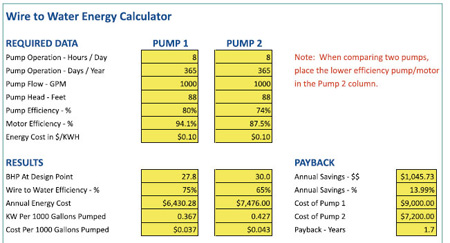Energy efficiency and reduced consumption are important issues in the pump and motor marketplace. Over the long term, electricity costs will continue to increase regardless of our actions. This will be due to increasing fuel costs and inflation, but if programs that limit CO2 emissions are enacted, energy costs will skyrocket. I belong to that group of those "not-so-green" scientists who do not believe that anthropogenic CO2 emissions have any measureable impact on global temperatures. That said, I am completely in favor of reducing energy consumption, but for a different reason-economics.
There are several ways to reduce energy costs in pumping applications. The first, and probably most important, is the application design. Well designed systems are usually far more efficient than poorly designed ones. Increasing pump hydraulic efficiency at the H/Q point reduces the BHP required. A reduction in BHP reduces the energy required per gallon pumped. Motor efficiency can also have a significant impact. Increased motor efficiency reduces the energy required to produce a certain BHP. When taken together, application design and wire-to-water efficiency can significantly reduce electrical consumption.
There are times, however, when pump efficiency can take a back seat to other important issues. For example, the efficiency of a vortex sewage pump can be 25 points lower than a standard non-clog pump with a similar flow and head (see my August 2007 column for more information). But, if plugging is a problem and the non-clog has to be pulled weekly, the maintenance costs will far exceed the increased power cost of the vortex pump. Even if a lower efficiency pump is the best choice for an application, a higher efficiency motor will still decrease the overall operating costs.
Figure 1 is a screen shot of my Excel-based, Wire-to-Water Energy Calculator. It is available for download in the "Pump Sizing & Selection Tools" section of my website (www.PumpEd101.com). The calculator allows evaluation of the electrical consumption of various pumps with the same motor, various motors with the same pump or various combinations of each. It also provides a simple "payback" analysis when comparing two different pump and motor combinations.

Figure 1
After entering the required data, the calculator will produce a number of results including the BHP required, wire-to-water efficiency and annual energy cost. KW and cost per thousand gallons pumped are also displayed. When you compare two different pump/motor combinations and enter the cost of each, the calculator will produce a simple payback analysis that displays annual savings and payback in years. Payback is simply the pump/motor cost differential divided by annual savings. Although a present value analysis may be needed in some instances, simple payback will usually provide the information needed to make a selection decision.

